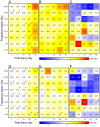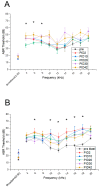Temporal Changes in Functional and Structural Neuronal Activities in Auditory System in Non-Severe Blast-Induced Tinnitus
- PMID: 37763802
- PMCID: PMC10535376
- DOI: 10.3390/medicina59091683
Temporal Changes in Functional and Structural Neuronal Activities in Auditory System in Non-Severe Blast-Induced Tinnitus
Abstract
Background and Objectives: Epidemiological data indicate that blast exposure is the most common morbidity responsible for mild TBI among Service Members (SMs) during recent military operations. Blast-induced tinnitus is a comorbidity frequently reported by veterans, and despite its wide prevalence, it is also one of the least understood. Tinnitus arising from blast exposure is usually associated with direct structural damage that results in a conductive and sensorineural impairment in the auditory system. Tinnitus is also believed to be initiated by abnormal neuronal activities and temporal changes in neuroplasticity. Clinically, it is observed that tinnitus is frequently accompanied by sleep disruption as well as increased anxiety. In this study, we elucidated some of the mechanistic aspects of sensorineural injury caused by exposure to both shock waves and impulsive noise. The isolated conductive auditory damage hypothesis was minimized by employing an animal model wherein both ears were protected. Materials and Methods: After the exposure, the animals' hearing circuitry status was evaluated via acoustic startle response (ASR) to distinguish between hearing loss and tinnitus. We also compared the blast-induced tinnitus against the well-established sodium salicylate-induced tinnitus model as the positive control. The state of the sensorineural auditory system was evaluated by auditory brainstem response (ABR), and this test helped examine the neuronal circuits between the cochlea and inferior colliculus. We then further evaluated the role of the excitatory and inhibitory neurotransmitter receptors and neuronal synapses in the auditory cortex (AC) injury after blast exposure. Results: We observed sustained elevated ABR thresholds in animals exposed to blast shock waves, while only transient ABR threshold shifts were observed in the impulsive noise group solely at the acute time point. These changes were in concert with the increased expression of ribbon synapses, which is suggestive of neuroinflammation and cellular energy metabolic disorder. It was also found that the onset of tinnitus was accompanied by anxiety, depression-like symptoms, and altered sleep patterns. By comparing the effects of shock wave exposure and impulsive noise exposure, we unveiled that the shock wave exerted more significant effects on tinnitus induction and sensorineural impairments when compared to impulsive noise. Conclusions: In this study, we systematically studied the auditory system structural and functional changes after blast injury, providing more significant insights into the pathophysiology of blast-induced tinnitus.
Keywords: blast overpressure; hearing loss; impulsive noise; tinnitus.
Conflict of interest statement
The authors declare no conflict of interest.
Figures













Similar articles
-
Central and peripheral auditory abnormalities in chinchilla animal model of blast-injury.Hear Res. 2021 Aug;407:108273. doi: 10.1016/j.heares.2021.108273. Epub 2021 May 15. Hear Res. 2021. PMID: 34139381
-
Effects of lifetime noise exposure on the middle-age human auditory brainstem response, tinnitus and speech-in-noise intelligibility.Hear Res. 2018 Aug;365:36-48. doi: 10.1016/j.heares.2018.06.003. Epub 2018 Jun 12. Hear Res. 2018. PMID: 29913342
-
Therapeutic effect of sildenafil on blast-induced tinnitus and auditory impairment.Neuroscience. 2014 Jun 6;269:367-82. doi: 10.1016/j.neuroscience.2014.03.020. Epub 2014 Mar 21. Neuroscience. 2014. PMID: 24662845
-
Hearing protection and damage mitigation in Chinchillas exposed to repeated low-intensity blasts.Hear Res. 2023 Mar 1;429:108703. doi: 10.1016/j.heares.2023.108703. Epub 2023 Jan 16. Hear Res. 2023. PMID: 36680874 Review.
-
Blast-induced tinnitus: Animal models.J Acoust Soc Am. 2019 Nov;146(5):3811. doi: 10.1121/1.5132551. J Acoust Soc Am. 2019. PMID: 31795642 Review.
References
-
- Remenschneider A.K., Lookabaugh S., Aliphas A., Brodsky J.R., Devaiah A.K., Dagher W., Grundfast K.M., Heman-Ackah S.E., Rubin S., Sillman J., et al. Otologic outcomes after blast injury: The Boston Marathon experience. Otol. Neurotol. 2014;35:1825–1834. doi: 10.1097/MAO.0000000000000616. - DOI - PubMed
-
- Metzger K., Akram H., Feldt B., Stone K., Alvey S., Henley S., Hernandez A., Melville S., Haywood T., Zane D. Epidemiologic Investigation of Injuries Associated With the 2013 Fertilizer Plant Explosion in West, Texas. Disaster Med. Public Health Prep. 2016;10:583–590. doi: 10.1017/dmp.2015.186. - DOI - PubMed
MeSH terms
LinkOut - more resources
Full Text Sources
Medical
Research Materials

